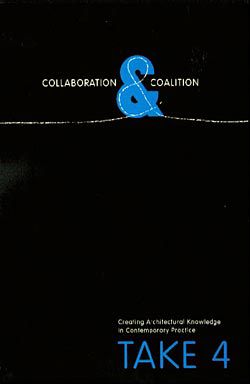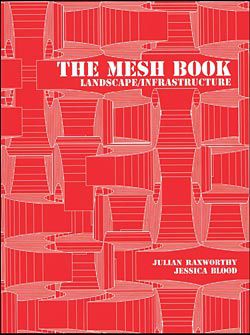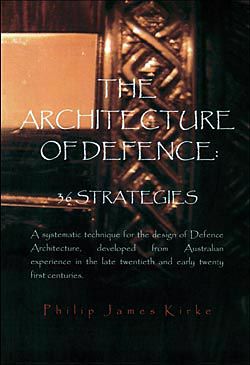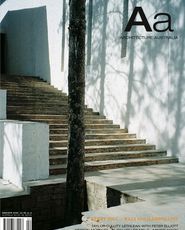TAKE 4: COLLABORATION AND COALITION

CREATING ARCHITECTURAL KNOWLEDGE IN CONTEMPORARY PRACTICE
Edited by Louise Wallis, Paula Whitman and Susan Savage. RAIA, 2005. $33. I like the intent of this book. Collaboration in the design process is a very worthwhile area of discussion in architectural practice, and examining collaboration through a series of case study essays by different authors seems a good way to do this. It is interesting too (and worth encouraging) that it is published by the RAIA and is the outcome of the longstanding Sisalation Prize. It is a fairly uncommon instance of our industry and our profession helping to create research which is closely aligned with practice, but not directly it.
The first essay (Baz Bill and Spud: Knowledge from Connection With Making) describes Gabriel Poole’s relationship with builders in making his architecture. This immediately gets into arguments which I find a little irritating. Firstly, the idea that it is novel to liaise with, and at times defer to, people carrying out the crafting of building.
Surely this is common enough, and it need not be accompanied by a sensibility which sets doing against thinking. This tired separation is always slightly antiintellectual – it seems to go with that frontier suspicion of the academy. My concern is that the collaboration is pitched as a one-way effort; the architect becoming more like a builder and suppressing what they undoubtedly bring to the collaborative table. If they are not bringing anything else to the table, then we might wonder what they’re doing there.
Generally the texts focus on the crafting collaboration – architect and steelworker, architect and engineer, architect as builder.
Lots of refined timber structures and butter paper. The best exception to this is Tokyo Speed: Recreating the Academy in Practice, a description of collaboration with related design firms sharing work and exhibition space. Here I was curious about the suggestion of spatial and personal proximity as key ingredients. There is almost no mention in this book of long-distance collaboration facilitated by digital tools, which is an area of rapidly growing interest.
A marvellous image of collaboration at a more fundamental level is provided in Phillip Crowther’s essay, which contrasts the three-legged race with the relay; the three-legged race being less efficient but more fun, and perhaps more like design collaboration. By extension, collaborative efforts slow each runner down but they produce something neither could have come up with alone. It reminds me a little of George Orwell’s assertion that democracy is messy and slow while Fascism is clean and efficient.
The main concluding point of these essays is that we do not know enough about architectural knowledge, and that describing collaborative methods might help expose that knowledge and make it more accessible. The difficulty of understanding what architectural knowledge is has real professional consequences. The authors cite the Productivity Commission’s inability to accept that a clear body of knowledge defines the profession, and should therefore be protected in the public interest. (And universities have their own difficulties in identifying our discipline’s research.)
The other point made in this book is that despite such pressures, it is pointless to suggest a clearly defined or fixed body of knowledge for our discipline. The case studies in Take 4 do not produce one and nor should they. This does not mean that we should not attempt to grapple with what it is that architecture is trying to do.
For this reason the individual stories of these essays, despite our various biases, are well worth reading. GRAHAM CRIST
THE MESH BOOK

LANDSCAPE/INFRASTRUCTURE
Edited by Julian Raxworthy and Jessica Blood. RMIT University Press, 2004. $44.The Mesh Book has emerged from the 2001 conference of the same name held at RMIT University. Like the conference, which was vigorous and well attended, the book covers a wide spectrum of approaches to the relationship between landscape and infrastructure: infrastructure as metaphor, infrastructure as delivery system, infrastructure as big chunky stuff, infrastructure as ephemeral enigmatic stuff, and, most importantly, infrastructure as really about landscape and not primarily about constructions of architecture or engineering. There is a strong thread of “reclaiming” infrastructure as a landscape issue, and in doing so, asserting landscape’s innate richness, openness, connectedness and agency.
The editors note that the very topic of infrastructure resists easy definition: “the closer you get to it, the more background there is behind it.” Robust visible structures, such as stormwater systems and motorways, are in fact there to enable quite different systems and structures to operate.
These systems and structures have their predispositions and non-utilitarian tendencies which may lie quite beyond our own current preoccupations or representational strategies.
Various permutations of constructedness and emergence are addressed in three main sections: invisible infrastructures, immanent infrastructures and present infrastructures. Some of the most engaging material propositions are from the work of Dutch landscape practice Vista, whose large-scale landscape interventions exploit the necessary control of hydrology in vulnerable low-lying land in a productive and unsentimental way. This work sits alongside other thought-provoking and innovative projects, and critical writings, which together create an important addition to the wider debates on landscape infrastructure and urbanism.
The book structure is not without some repetition and limitation. There are about four different introductions, each defining parameters for the idea of infrastructure and landscape, or asserting a classification of infrastructural strategy and effect. The editorial voice is complicated by the landscape architectural academic Peter Connelly’s critique of other chapters within his own. This gives the sense that the book is functioning like a post-conference after-party conversation – not simply a report on the state of things but a determined effort to dig deeper (forgive the heavy machinery allusion) into the ways in which the practice of landscape architecture conducts its investigations, and how the very idea of landscape is conceived. KATRINA SIMON
THE ARCHITECTURE OF DEFENCE

36 STRATEGIES
Philip James Kirke. Friend Books, 2005. $36. A treatise by a West Australian architect, this little book presents a designer’s resistance to the intellectual dominance of engineering and project management thinking. Less evangelical than Pattern Language, more the way I remember the Team 10 Primer to be, Kirke’s book gives us an insight into how a concern for environmental, social and human values can give architectural shape, form and expression to an unlikely building type – defence buildings. It is written with a touch of rye humour and has a thoughtful logic and structure.
Like Norberg-Schulz, Kirke argues for reconnecting feeling with thinking. He focuses on the physical, cognitive and motivational effects that architectural place-making can have on people – from how we use the land to how we design the micro scale of a workplace – through four themes. Two of them are about people-topeople relationships – internally, and with the broader community. The third is about protecting people and equipment, and the fourth is about the particular task needs of people and equipment. The use of thirty-six strategies in an idiomatic form is a “nod” to traditional Chinese folk literature on military logic.
Kirke was a senior architect with GHD for some 18 years, and is now an associate with Hassell in Perth. He has worked with Indigenous communities in WA and has published a number of children’s books.
Kirke’s views on architecture and what drives the making of a satisfying outcome are transferable to many building types.
This book is well worth a read. PROFESSOR GRAHAM BRAWN
BOOKS ARE AVAILABLE AT ARCHITEXT Tusculum, 3 Manning Street, Sydney, T 02 9356 2022 E architext@raia.com.au 41 Exhibition Street, Melbourne.
T 03 9650 3474 sydney@architext.com.au W www.architext.com.auThe Architecture of Defence is available directly from the publisher: Friend Books, 99 Corinthian Road West, Shelley, WA 6148.















